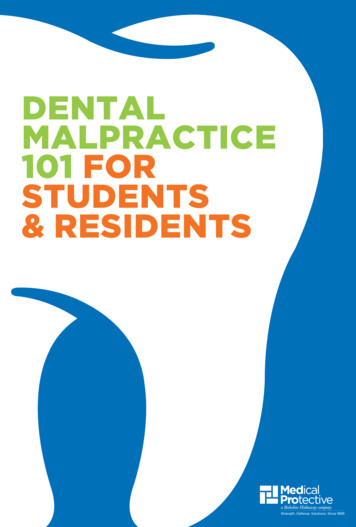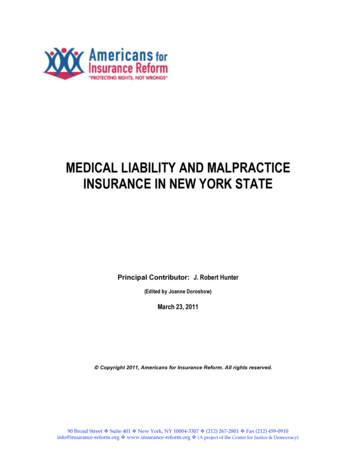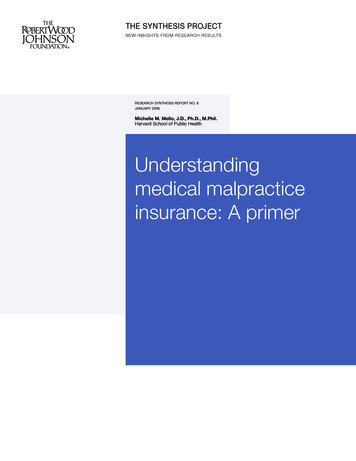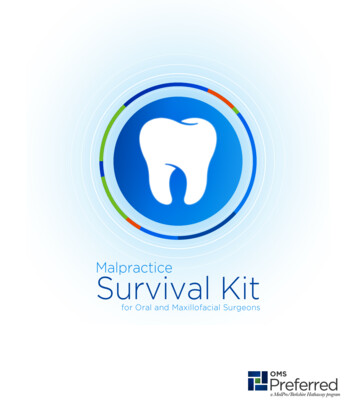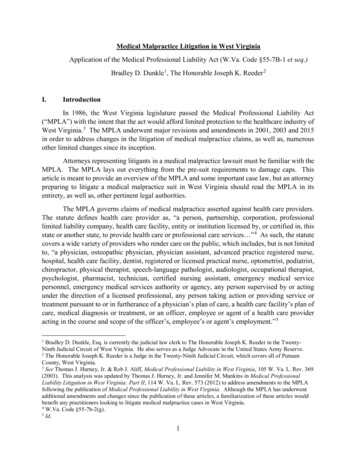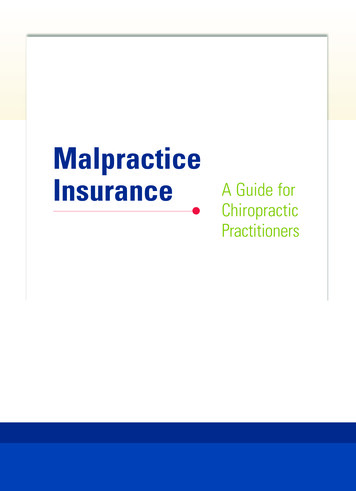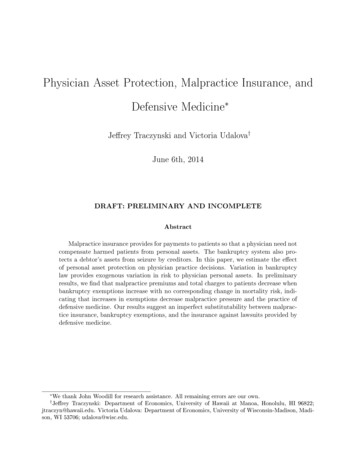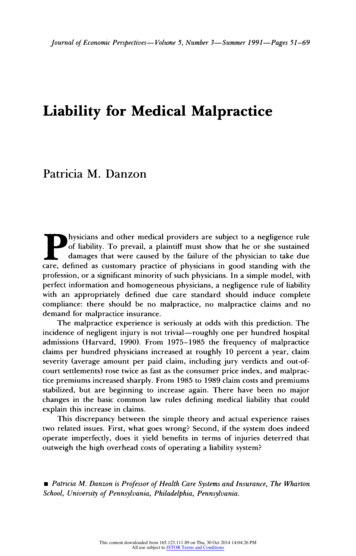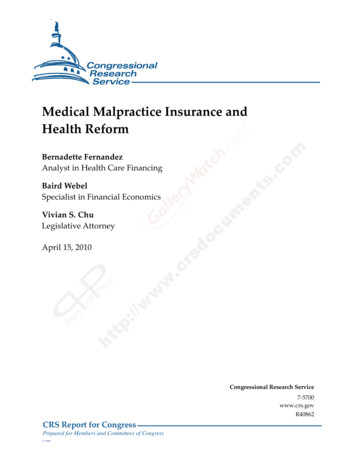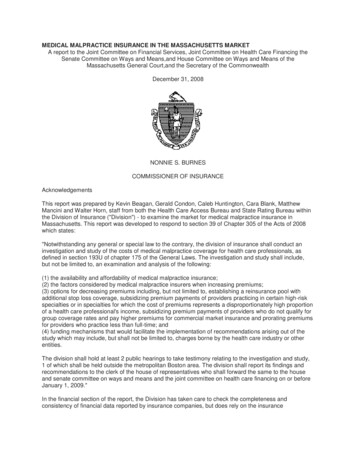
Transcription
MEDICAL MALPRACTICE INSURANCE IN THE MASSACHUSETTS MARKETA report to the Joint Committee on Financial Services, Joint Committee on Health Care Financing theSenate Committee on Ways and Means,and House Committee on Ways and Means of theMassachusetts General Court,and the Secretary of the CommonwealthDecember 31, 2008NONNIE S. BURNESCOMMISSIONER OF INSURANCEAcknowledgementsThis report was prepared by Kevin Beagan, Gerald Condon, Caleb Huntington, Cara Blank, MatthewMancini and Walter Horn, staff from both the Health Care Access Bureau and State Rating Bureau withinthe Division of Insurance ("Division") - to examine the market for medical malpractice insurance inMassachusetts. This report was developed to respond to section 39 of Chapter 305 of the Acts of 2008which states:"Notwithstanding any general or special law to the contrary, the division of insurance shall conduct aninvestigation and study of the costs of medical malpractice coverage for health care professionals, asdefined in section 193U of chapter 175 of the General Laws. The investigation and study shall include,but not be limited to, an examination and analysis of the following:(1) the availability and affordability of medical malpractice insurance;(2) the factors considered by medical malpractice insurers when increasing premiums;(3) options for decreasing premiums including, but not limited to, establishing a reinsurance pool withadditional stop loss coverage, subsidizing premium payments of providers practicing in certain high-riskspecialties or in specialties for which the cost of premiums represents a disproportionately high proportionof a health care professional's income, subsidizing premium payments of providers who do not qualify forgroup coverage rates and pay higher premiums for commercial market insurance and prorating premiumsfor providers who practice less than full-time; and(4) funding mechanisms that would facilitate the implementation of recommendations arising out of thestudy which may include, but shall not be limited to, charges borne by the health care industry or otherentities.The division shall hold at least 2 public hearings to take testimony relating to the investigation and study,1 of which shall be held outside the metropolitan Boston area. The division shall report its findings andrecommendations to the clerk of the house of representatives who shall forward the same to the houseand senate committee on ways and means and the joint committee on health care financing on or beforeJanuary 1, 2009."In the financial section of the report, the Division has taken care to check the completeness andconsistency of financial data reported by insurance companies, but does rely on the insurance
companies, the National Association of Insurance Commissioners and other regulatory agencies for theaccuracy of all reported information.Within others sections of the document, the report looks at proposals to address medical malpractice andthe pros and cons of each without making any specific recommendation on any proposal.TABLE OF CONTENTSAcknowledgmentsTable of ContentsIncluded FiguresExecutive SummaryMassachusetts Health Care ProfessionalsNumber of ProfessionalsLiability Coverage RequirementsMarket for Medical Malpractice CoverageHistoryLicensed Insurance CompaniesSurplus Lines CarriersRisk Retention GroupsShares of the MarketFinancial Results for Insurance CarriersPremiumsCostsLoss RatiosCombined Ratios and Operating RatiosPremiums for Medical Malpractice CoverageFactors Affecting the Cost of CoverageReasons for Rate Increases in the Early 2000sMassachusetts Premium Changes in the 2000sPremiums Compared to Those of Other StatesOptions for Decreasing PremiumsCommunicationsEnterprise LiabilityTort ReformMedical ReformEstablishing a Reinsurance PoolPremium Differences Between Health Care ProfessionalsNumbers of Physicians Available for CareAddressing Premiums for Certain High-Risk SpecialtiesProrating Premiums for Those Who Practice Less than Full-Time ConclusionAppendix A-1: Medical Malpractice Insurance CompaniesAppendix A-2: Medical Malpractice Surplus Lines CarriersAppendix A-3: Medical Malpractice Risk Retention GroupsIncluded FiguresFigure 1 2007 Property and Casualty Premium by Line of CoverageFigure 2 Share of 2007 Insurance Company Market
Figure 3 Share of 2007 Surplus Lines Carrier MarketFigure 4 Share of 2007 Risk Retention Group MarketFigure 5 Shares of 2007 Combined Medical Malpractice MarketFigure 6 Total Market 2001, 2004 and 2007 (Combined Medical Malpractice Market)Figure 7 Total Market Premiums Earned (by Type of Company [2001, 2004 and 2007])Figure 8 Total Market Losses (by Type of Company [2001, 2004 and 2007])Figure 9 Total Market Loss RatiosFigure 10 Total MA Market Loss Ratios by Type of CompanyFigure 11 Calculation of Adjusted Combined Ratios - Licensed CompaniesFigure 12 ProMutual Annual Rate Changes for Physicians/Surgeons (2001-2008)Figure 13 NPDB 2006 Annual Report - Table 13Figure 14 ProMutual's Rates for Claims Made Policies for Northeast StatesFigure 15 Massachusetts Medical Malpractice Reinsurance Plan (Jan 2000-Jan 2008)Figure 16 Fifteen Highest Rated Specialties for Number of Claims, 1994 -2003Figure 17 Amount Paid by Medical Specialty, 1994-2003Figure 18 Massachusetts Registered Physicians by County (2001/ 2007)Figure 19 Massachusetts Registered General Practitioners by County (2001/ 2007)Figure 20 Massachusetts Registered Emergency Physicians by County (2001/ 2007)Figure 21 Massachusetts Registered Obstetricians/Gynecologists by County (2001/ 2007)Executive SummaryHealth care professionals make daily decisions about treatment where they balance the need to use newprocedures with the need to avoid errors that may harm patients. When an error may have occurred andmalpractice is claimed, medical malpractice insurance covers the cost to defend professionals and payclaims for damages.Massachusetts law requires that doctors have medical malpractice coverage [1] and that insurancecompanies make medical malpractice coverage available on an equal basis to all doctors and certainother licensed healthcare providers willing to pay for it. [2] Despite the availability of coverage, some haveindicated that the cost of coverage is forcing them to think about dropping their practices or moving toother states to practice.Among the material presented in this report: Total Massachusetts medical malpractice premiums increased from 198 million in 2001 to 301 million in2007; an increase of over 50% in six years. Risk Retention Groups account for 10% more of the market in2007 than in 2001.
During the first half of the 2000's, the market for medical malpractice coverage was in disarray nationallyand in Massachusetts. National companies were dropping coverage and others were filing for double digitrate increases. Over the past few years, Massachusetts medical malpractice insurers' net operating ratios- company expenses compared to premiums - declined from 149.5% in 2001 to 84.3% in 2007, fewercompanies left the market and average rates increased only gradually. There have been many unstable periods over the past thirty-five years in medical malpractice. Many arelooking at the reasons that claims and defense costs, administrative expenses, reinsurance costs andinvestment returns impact the overall cost of medical malpractice coverage to eliminate the periods ofinstability. Since projected trends in malpractice claims have a great impact on cost, many are looking atways to address the frequency (number) and severity (size) of medical malpractice claims by looking atthe following types of changes: Improving communications between patients and health care professionals to improve trust, reduceunreasonable expectations and avoid lawsuits; Shifting malpractice risk to enterprises - e.g., hospitals and health plans - because systems problems areresponsible for many medical errors. Changing the tort system - e.g., limiting medical malpractice awards and establishing new procedural tortstandards - to reduce unnecessary lawsuits; Preventing medical errors - e.g., disclosing all medical errors and establishing medical standards of care to reduce patient injuries; and
Certain specialties ( e.g., obstetrics and gynecology) have higher claims and higher premiums than doother specialties. Some are looking at ways to temper these specialties' premiums to by looking at thefollowing types of changes: Increasing other providers' premiums to subsidize high-risk providers' premiums; Assessing other insurers' to subsidize high-cost providers' premiums; and Establishing limited no-fault systems to review claims for high-cost providers.The Division of Insurance finds that medical malpractice is complicated and much debated without easysolutions. More research is needed to assess the proposed ideas in relation to the workings of theMassachusetts health care delivery system to evaluate the best course of action and the projected costsof those actions.Massachusetts' Health Care ProfessionalsNumber of ProfessionalsIn 2006, there were over 225,000 individual health care professionals licensed by state agencies topractice in the following licensing categories: [3]130,283 Nurses21,599 Social Workers20,740 Medical and Osteopathic Doctors8,273 Allied Health Providers (Therapists and Athletic Trainers)6,925 Dentists5,466 Allied Mental Health Providers
5,183 Psychologists4,497 Audiologists and Speech Pathologists3,284 Respiratory Care Specialists (full and limited licenses)2,145 Chiropractors1,956 Dietitians/Nutritionists1,820 Dispensing Opticians1,692 Physician Assistants1,484 Optometrists950 Acupuncturists569 Podiatrists155 Hearing Instrument Specialists
130 Certified Health Officers98 Perfusionists (full and provisional licenses)In addition to the above-noted individual professionals, there were almost 1,400 facilities and programslicensed to operate under the following types of entities: [4]533 Nursing Homes/Assistant Living Residences/Rest Homes250 Clinics188 Home Health Care Agencies177 Mammography Facilities132 Hospitals (acute care, psychiatric and rehabilitation)56 Ambulance services53 HospicesIn order to practice in the Commonwealth of Massachusetts, a health care professional must be licensedor registered by agencies such as the Board of Registration in Medicine, [5] the Division of ProfessionalLicensure, [6] Boards of Registration, [7] the Department of Mental Health [8] or the Department of PublicHealth. [9] A health care professional may also need to satisfy additional training to represent that he orshe is specially trained or board-certified in a specialty and may need to meet other requirements topractice in a hospital or to be included in a health plan network.Liability Coverage RequirementsAlmost all working professionals have professional liability coverage to protect them from claims fordamages if work is not completed according to agreed-upon standards or expected outcomes. Health
care professional require special liability coverage because they treat living bodies without the sametypes of expected outcomes. Even when a health care professional's decision may be correct based uponavailable information, there can be bad outcomes with long-term financial consequences. This liabilitycoverage pays the cost to defend the health care professional's reputation and cover the potential cost ofdamages.In Massachusetts, companies that offer medical malpractice insurance are required to make coverageavailable on a "take all comers" basis - without declining the coverage of any one professional - for allwho fall within the following statutorily identified categories whenever that insurance company is makingcoverage available to anyone else who is in that category:Doctor of Medicine;Doctor of Osteopathy;Doctor of Dental Science;Doctor of Podiatry;Doctors of Chiropractic;Registered Nurses, licensed under the provisions of M.G.L. c. 112;Interns, fellows or medical officers; andLicensed hospitals, clinics, or nursing homes, and their agents and employees. [10]All other health care professionals outside the statutorily identified categories may apply for coverage withinsurance companies, but the company has the right to decline coverage for these other health careprofessionals if they do not meet the insurer's underwriting standards.It is a specific requirement of licensure that medical doctors have medical malpractice coverage sufficientto protect against claims of at least 100,000 per occurrence and 300,000 per year [11] and thatchiropractors are required to have coverage of at least 500,000 per occurrence and 1.0 million peryear. [12] Hospitals and health plans may impose additional requirements to permit health careprofessionals to practice in the hospital or to be part of a health plan network.Market for Medical Malpractice CoverageHistoryMedical malpractice insurance has gone through a number of national and regional "crises" over the past35 years, with years of stability and available coverage, followed by years of rate increases anddecreased coverage. Following the departure of a number of medical malpractice insurers from theCommonwealth in the 1970s, the Massachusetts Legislature created the Medical Malpractice JointUnderwriting Association (MMJUA) to offer access to coverage for certain medical professionals andauthorized the MMJUA to assess other medical malpractice carriers for certain losses. [13]During the 1980s, the medical malpractice insurance industry developed new types of policies to stabilizelosses and premiums. While policies written before the change were "occurrence-based" policies(covering all claims filed for an incident that occurred during a coverage year), many insurers switched to"claims-made" policies (covering only claims filed during a coverage year. [14] Since losses under claimsmade policies are more predictable, the new products enabled companies to stabilize their ratingpractices. [15]In 1994 Massachusetts passed legislation to transform the MMJUA into the Medical Professional MutualInsurance Company ("ProMutual") with a board composed mainly of practicing or retired healthcareproviders [16]Since its inception, ProMutual has been the one of the largest medical malpracticeinsurance companies and few companies have entered the Massachusetts market. [17]Licensed Insurance CompaniesMedical malpractice insurance companies must be licensed by the Division of Insurance with adesignation for medical malpractice insurer and are required participants in the state's guaranty fund to
protect policyholders in the event of an insurer's insolvency. Medical malpractice is a specializedcoverage accounting for 173.2 million in direct written premium which is about 1.6% of all property andcasualty coverage. (Figure 1)Figure 1The Division of Insurance maintains a list of medical malpractice insurance companieson www.mass.gov/doi/consumeridentifying the "take all comers" classes of health care professionalswritten by the company. The list of licensed insurance companies writing medical malpractice coverage in2007 is in Appendix A-1 on page 39.
Figure2The ProMutual Insurance Group - composed of Medical Professional Mutual Insurance Company andProSelect Insurance Company - had the predominant share of the 2007 insurance market collectingapproximately 83% of total premium. (Figure 2)Surplus Lines CarriersSeparate from the licensed insurance companies, health care professionals may also turn to surplus linescarriers for medical malpractice coverage. Surplus lines carriers are not licensed in Massachusetts butare licensed as an insurer in another jurisdiction and can issue coverage through specially licensedbrokers to those who cannot obtain coverage from insurers licensed to do business in Massachusetts.Surplus lines carriers are not subject to state insurance law - such as the "take all comers" requirements and do not participate in Massachusetts's guaranty fund. The Division maintains a list of surplus linescarriers on www.mass.gov/doi/consumer. The list of surplus lines carriers writing medical malpracticecoverage in 2007 is in Appendix A-2 on page 40.
Figure 3The largest surplus lines medical malpractice carriers are the American International Group (includesLexington Insurance Company) and White Mountains Group, accounting respectively for 28.3% and11.4% of the 2007 medical malpractice surplus lines market. (Figure 3)Risk Retention GroupsSeparate from both insurance companies and surplus lines carriers, medical malpractice coverage mayalso be offered through Risk Retention Groups (RRG) which under federal law [18] may offer liabilitycoverage in any state provided the RRG is licensed as an insurance company in at least one state. RRGsare specifically exempted by federal law from participation in state guaranty funds and are not subject tothe "take all comers" requirements that apply to licensed insurance companies.Under federal law,1. An RRG can be formed and owned only be members who are engaged in a similar business or activityand with similar liability risk exposure; and.2. An RRG cannot exclude eligible members solely to reduce the RRG's risk of loss.
Figure 4The Controlled Risk Insurance Company of Vermont RRG - also known as CRICO - has the predominantshare of the RRG medical malpractice market collecting over 87% of premium in 2007. CRICO wascreated in 1979 to provide professional liability coverage to the physicians and employees of Harvardaffiliated medical institutions. [19]According to CRICO's business plan, physician applicants must meetCRICO underwriting criteria and are assigned to one of 80 underwriting specialties based on level of riskexposure.Each of the 4 next largest RRGs collectively account for about 10% of the market, and some of themwrite coverage for specialty providers. The list of RRGs who were writing medical malpractice coverage in2007 is in Appendix A-3 on page 41.Shares of the MarketDuring 2007, the different carriers together wrote 301.4 million of medical malpractice premium with57.6% written by insurance companies, 35.6% written by RRGs and 6.9% written by surplus linescarriers. (Figure 5)
Figure 5This distribution changed since 2001 when 69.5% was written by insurance companies, 24.6% waswritten by RRGs and 5.8% was written by surplus lines carriers. (Figure 6)Figure 6Financial Results for Insurance Carriers
PremiumsThe 307.1 million earned in 2007 by insurance companies, surplus lines carriers and RRGs was 11.9%more than the 274.4 million earned in 2004 and 67.9% more than the 182.9 million earned in 2001.(Figure 7)On an industry basis, licensed insurance companies earned 175.2 million in premiums in 2007 - 2.0%higher than the 171.8 million earned in 2004 and 37.7% more than the 127.2 million earned in 2001.RRGs earned 107.4 million in 2007 - 48.1% higher than the 72.5 million earned in 2004 and 121.4%more than the 48.5 million earned in 2001. Surplus lines carriers earned 24.5 million - 16.6% less thanthe 30.1 earned in 2004 and 240.3% more than the 7.2 million earned in 2001. (Figure 7)Figure 7CostsWhen setting premiums, companies need to account for projected medical malpractice claims, as well asloss adjustment expenses (designed to settle or defend claims), general administrative expenses,producer commissions, and reinsurance expenses. Claims dollars are important drivers of overall costs,but examining claims dollars on financial reports may not present a true picture of losses to compare withcompany premiums. In Massachusetts medical malpractice claims are resolved 6 years [20] following themalpractice incident. Reported losses may be associated with premiums that were collected 6 years ago.
Figure8Massachusetts licensed insurance companies reported total claims losses of 158.4 million in 2001,greater than the 127.2 million collected in premiums.On an industry basis, licensed insurance companies had incurred claims - those amounts that werereserved for claims that were open in the current year as well as amounts paid out for claims during ayear - of 93.1 million 2007 - 3.4% less than the 96.2 million incurred in 2004 and 41.3% less than the 158.4 million incurred in 2001. RRGs incurred 60.6 million in 2007 - 21.4% higher than the 49.8million incurred in 2004 and 46.1% more than the 41.4 million incurred in 2001. Surplus lines carriersincurred 7.1 million in claims - 39.4% less than the 11.8 incurred in 2004 and 3.4% more than the 6.9million collected in 2001. (Figure 8)Loss RatiosMany use loss ratios (incurred losses divided by earned premium) to predict the underwriting success orfailure of property insurance companies and assume that the lower the loss ratio, the higher thecompany's profitThe calculated loss ratios for Massachusetts medical malpractice companies (licensed insurers, RRGsand surplus lines carriers) declined from 113.0% in 2001 to 52.4% in 2007. The loss ratios on a nationalbasis for all medical malpractice companies declined from 100.4% in 2001 to 41.6% in 2007. (Figure 9)
Figure 9When examining each of the types of medical malpractice carriers in Massachusetts, the loss ratiosdecline for each. The licensed insurance companies' loss ratios declined from 124.5% in 2001 to 53.1% in2007. The RRGs' loss ratios declined during this period from 85.3% in 2001 to 56.5% in 2007. Thesurplus lines carriers' loss ratios declined from a 96.1% in 2001 to 29.0% in 2007. (Figure 10)Figure 10Combined Ratios and Operating RatiosAn adjusted combined ratio (the combination of company expenses and incurred claims divided byearned premium) can be a more effective measure of the overall experience of a property and casualtyinsurance company since it factors in other costs required to run an insurance company, including lossadjustment, acquisition and general expenses, as well as the costs of taxes, licensing fees, and mutualfund dividends.
Since companies do not report company-by-company expense experience, the following table - Figure 11- derives general and other expenses based on aggregate reported financial information for licensedinsurers - not including the RRGs and surplus lines carriers. The adjusted combined ratio with dividendscalculation - column (L) - presents a more complete picture of company experience in the medicalmalpractice market. While the loss ratio for 2007 was 53.1%, the net operating ratio was 105.8%.Figure 11Figure 11 includes one more calculation to derive a net operating ratio that is more reflective of medicalmalpractice insurance experience. Since medical malpractice is considered a "long-tailed line" wherepayments may not be made for many years after a claim has been filed, the net operating ratio considersthe net investment income on reserves held to pay future claims. As illustrated in column (N) of Figure 11when factoring in the net investment income ration, the net operating ratio for licensed medicalmalpractice insurers was 149.5% in 2001, 81.8% in 2004 and 84.3% in 2007.The above analysis does not reflect the net cost of reinsurance because this information is not readilyavailable within the aggregate financial statements for Massachusetts medical malpractice business.Based upon industry information, reinsurance is estimated to account for an additional 2-5% of acompany's premiums. [21]Premiums for Medical Malpractice CoverageFactors Affecting the Cost of CoverageInsurance company actuaries develop premiums to pay future expected claims losses and expenses,while also meeting company profit expectations and staying competitive with other insurance companies.ClaimsActuaries examine prior losses and loss adjustment expenses to estimate trends in both frequency (thenumber of lawsuits filed) and severity (average claims payments per claim. Projecting future losses formedical malpractice is complicated because in such a "long-tailed line," claims may not be settled for 5-7years after an initial claim is filed. [22]Defense CostsMedical malpractice claims may involve substantial legal costs to investigate and defend health careprofessionals from alleged negligence. Actuaries factor in projected cost of legal work leading up to andincluding the trying of a case.
Acquisition Costs, General Administrative Expenses and TaxesIn the course of doing business, companies pay commissions to producers ( i.e., agents or brokers) toacquire business, general administrative expense to operate their businesses and premium taxes andassessments.DividendsInsurance companies that are owned by investors (stock companies) or by policyholders (mutualcompanies) share their surpluses with their owners through dividend distributions. The level of dividendsdepends on ownership's expectations of surpluses.ReinsuranceMedical malpractice insurance carriers protect themselves from the financial risk of severe medicalmalpractice claims by purchasing reinsurance. This will vary based upon the availability of reinsuranceand the risk of the reinsured coverage.Investment ReturnsMedical malpractice insurers depend on investment earnings on claims reserves to pay future claims.When investment returns are expected to decrease, the company needs to collect more in premium toattain an adequate level to pay future claims.Risk ClassificationsCarriers develop different risk classes and rates for medical specialties based on prior and expected lossexperience. The classifications of risk must be reasonable and developed based on sound actuarialprinciples.Reasons for Rate Increases in the Early 2000sSome claim that "perfect storm" conditions [23] existed in the financial and insurance markets in the early2000s that caused spikes nationally in medical malpractice rates.1. Investment income fellMedical malpractice insurance companies invest primarily in conservative investments to earn returns onreserves to pay future claims. Some claim that when stock and bond yields fell in the early 2000s,companies could no longer rely on the same level of investment return on reserves [24] companies raisedpremiums to offset the lower expected earnings on reserves.2. Premiums did not keep up with changes in incurred claimsSome claim medical malpractice premiums were kept low while companies were aggressively competingfor market share in the late 1990s so that companies could attract premiums to invest in the financialmarkets When the financial markets changed, companies focused more on pricing to pay for the level ofactuarially projected claims. [25]3. Reinsurance expenses increasedMedical malpractice insurers need reinsurance for the exposure of many high-cost claims. Some claimreinsurance became less available and more expensive in the early 2000s following the World TradeCenter attacks and the Gulf Coast hurricanes. [26]4. Coverage became less available as companies stopped renewing policiesSome claim that premiums rose as insurance carriers - including the largest national insurer, The St. PaulCompanies - withdrew from writing medical malpractice insurance. [27] The remaining companies did pickup the business of the withdrawing companies but with increased administrative expenses.Massachusetts Premiums Change in the 2000sBased upon the rate history of Medical Professional Mutual Insurance Company (part of the ProMutualInsurance Group), rates did rise quickly in the early 2000's. Between 2000 and 2004, ProMutual's
physician and surgeon average rates increased each year by at least 9.0% over the previous year's rates.After 2004, ProMutual's rates were much more stable. (Figure 12)Figure 12During this period, it also appears that the number (frequency) of Massachusetts medical malpracticeclaims that were paid also increased. According to the National Practitioner Data Bank, the annualnumber of medical malpractice claims that were paid for Massachusetts physicians increased from the227 paid in 2002 to 273 in 2007. This is an increase of 46 claims or 20% above what was reported for2002. [28]Regarding the size of paid claims (the severity of claims), Massachusetts continues to have high averagepayouts compared to that of other states. In 2006, the average Massachusetts medical malpracticepayment made on behalf of practitioners was 465,236; the median payment was 300,000. Whenexamining claim payments made over the sixteen years between September 1, 1990 and December 31,2006, Massachusetts' median payment was the second highest nationally, only behind that of the state ofIllinois. (Figure 13)
Figure 13 [29]Premiums Compared to Those of Other StatesProMutual submitted materials to supplement testimony it presented at the October 3, 2008 hearing
presenting the rates the company charges by physician specialty in six Northeast states. [30] The ratesthat the company charges in Massachusetts and Connecticut are among the highest of the six states, butnot for every specialty. (Figure 14)Figure 14Among the specialty groups, Massachusetts' average rates for the obstetrician rating classes (80153and 80168) -are 104,481; this is similar to five other states, but over 40,000 more than charged in NewHampshire. For the related gynecology only rating class (80167), Massachusetts' average rates are 43,643; this is relatively similar to that of the other states.Options for Decreasing PremiumsMedical malpractice insurance actuaries calculate premiums to cover projected claims, expenses, taxesand dividends The premiums that they calculate will change based upon projected changes in claims,expenses, taxes, reinsurance and expected rates of return. While financial investment returns, premiumtax policy and the availability of reinsurance impact insurance carriers' need for premium, they are notspecific to medical malpractice and are beyond the scope of this report. This section looks at medicalmalpractice and ways to lower claims as a means of affecting premiums.Health care professionals buy medical malpractice coverage to protect themselves from
the Division of Insurance ("Division") - to examine the market for medical malpractice insurance in Massachusetts. This report was developed to respond to section 39 of Chapter 305 of the Acts of 2008 which states: "Notwithstanding any general or special law to the contrary, the division of insurance shall conduct an


